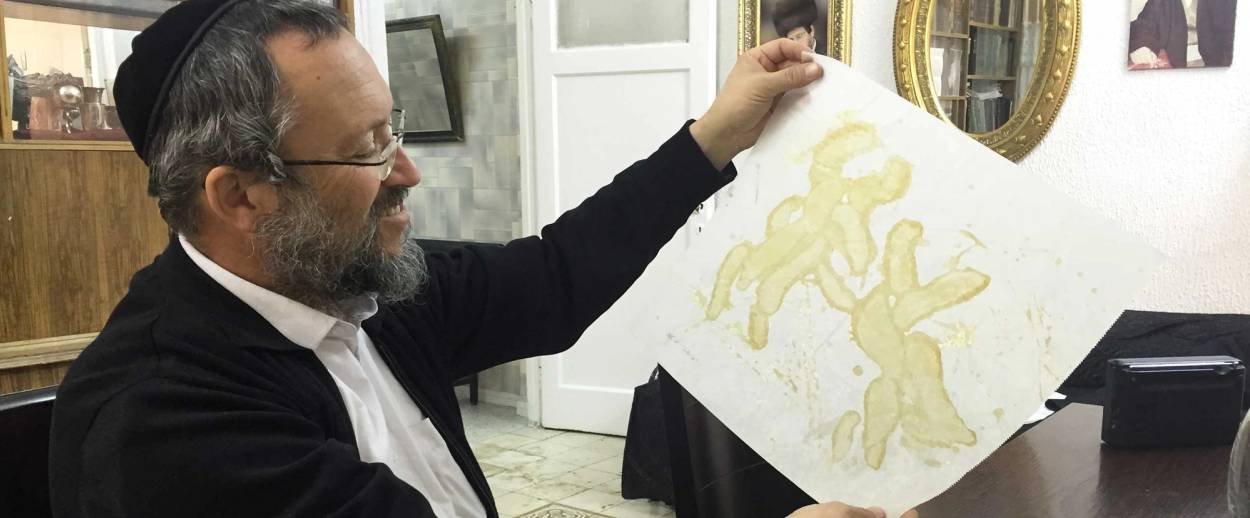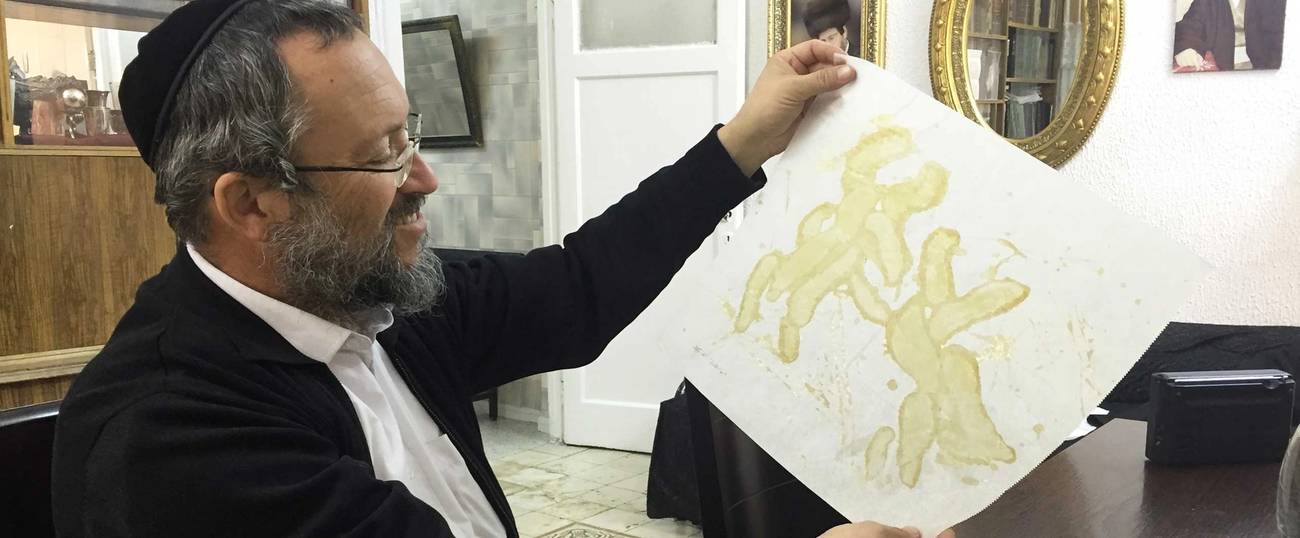Finishing the (Black) Hat
In Israel, ultra-Orthodox artists start to make their mark




On an afternoon last November, Motta Brim and his mother sat in a two-bedroom apartment in Jerusalem’s ultra-Orthodox Geula neighborhood . Brim sat at the dining table, flipping through five decades of his paintings and sketches, under the gaze of portraits of his grandfather and the grand rebbe of the Boyan Hasidic dynasty, to which the family belongs. His mother, a seamstress who cuts her own patterns from old newspapers, was working in the bedroom that Brim once shared with his 12 siblings. All those siblings, and Brim himself, have grown up, married, and moved out. Their father, a former headmaster at a religious boys’ school, died seven years ago.
So visiting his mother reminds Brim, now in his 50s, of one of the formative rituals of his childhood: days when his mother helped him skip cheder so that he could stay home and draw in a quiet house. On those days, while Brim stayed in bed in the morning, his mother would report that he was sick. Then when his father and the other children left the house, Brim would spread papers out on the tile floor and draw landscapes, still-lifes, and Biblical scenes while his mother sewed.
“Just before they would come home, my mother would tell me to get back in bed and pretend to be asleep,” Brim recalled with a smile. “This was something I needed. I needed to draw.”
Now Brim, who has remained part of the Boyan movement and spent many years teaching in a cheder, makes a living from his art. He has sold works to the Israel Museum and to art galleries, and has regularly shown in exhibitions throughout Israel.
Once an anomaly, even featured on the Israeli evening news for his own art and for teaching his cheder students to draw, Brim is now among a growing number of Haredi artists contributing to Jerusalem’s contemporary art scene. More Haredi artists are participating in exhibitions, public art initiatives and seeking academic and professional training in the field. In addition to joining existing institutions, they are also carving out their own spaces, opening studios and galleries that cater specifically to their community’s needs for modesty and separation of the genders.
“Not only are more religious people entering the art world, but those in the art world appreciate it,” said Jenna Romano, founder of Contemporary Art in Jerusalem, which offers gallery tours and promotes the city’s art scene.

In many ways, the slow growth of art coming out of the Israeli Haredi world is similar to other changes in this society. In the last decade, more Haredi men, who traditionally spent their days studying religious texts instead of working, have joined the workforce. Some boys’ schools have begun to teach secular subjects, like math and English, in addition to the standard curriculum of religious texts. And Haredi women are now represented in almost every profession.
“The world is more open now,” Brim said. “The community is not as closed, not as small.”
*
Recently, the Haredi artist has emerged as a sort of pop-cultural phenomenon here, due partly to the character of Akiva, the aspiring artist and cheder teacher, on the award-winning Israeli television series Shtisel, a drama, soon be adapted for a U.S. audience on Amazon Prime, about an extended Haredi family. In fact, Brim was part of the inspiration for the character of Akiva, with the show’s director consulting him several times on the realities of life as a Haredi artist. In the show, Akiva causes ripples in his family and tests the boundaries of his community, where traditionally the focus is on studying religious texts and living out Torah commandments, by selling his work to an art gallery, exhibiting it in the Israel Museum, and talking about it on national television. Like Brim, he is a teacher who uses drawing to explain Bible stories to his young students.
Within the community, many view Akiva’s artwork as a waste of time that should be spent learning Torah and looking for a suitable wife. But there are fleeting moments when others see the beauty in his work. When Akiva paints a portrait of his deceased mother that shows some hair peeking out from under her snood, his father initially thinks it is so inappropriate that he purchases the painting in order to destroy it. But he is unable to follow through with his plan to burn the picture of his dead wife, and eventually just covers up the hair with more paint.
“The series tells a beautiful story of an artist,” said Rami Ozeri, director of the Jerusalem Biennale for Contemporary Jewish Art, which has in recent years included an exhibition area for Haredi artists, away from exhibits that may contain nudity or other images not accepted in Haredi society. “But, still, Haredi people doing art are considered strange in their communities.”
Yet Brim’s Haredi background, like Akiva’s on the show, has drawn positive attention and opportunities from curators and museums.
“Being Haredi is something unique that I bring,” said Brim, who is married with five children and lives in Modi’in Ilit, a Haredi town. “If I were secular, I would just be like everyone else trying to make a living from art.”
In Jerusalem’s neighboring Romema district, another ultra-Orthodox artist, Rivka Vardi, has been a key pioneer in the expansion of art in the Haredi sector. Vardi, the director of Oman School of Higher Education for the Arts, which began offering art education in the Haredi sector more than a decade ago, has seen art go from something completely unknown in the community to something sought out by an increasing number of people.
When Vardi, who started drawing as a child, advertised her first community art class for ultra-Orthodox women, only a few people showed up. “It wasn’t popular and it wasn’t even clear what we did.” she recalled. “People were very puzzled, because they wanted to only make practical things, to do something for the sake of making art was not even heard of.”
Slowly, the program grew, and now Oman offers community art classes for both men and women, professional art certificate programs, and even a joint bachelor’s degree, with Jerusalem’s renowned Bezalel Academy of Arts and Design, in art for Haredi women. At the end of this school year, the first class will graduate from that joint four-year bachelor’s program. Next year, tracks will be added in fashion and graphic art. Eventually, Vardi said, there will be a degree program for men.
“I won’t say that we are changing Haredi society, because that’s not modest, and it’s not something that happens right away,” Vardi said. “But I will say that we are influencing Haredi society slowly, and providing more opportunities for self-expression. Doing art changes people. It makes them more open. We see people’s lives change for the better once they begin to make art. It opens new doors and opportunities for them.”
In the bachelor’s degree program, Bezalel professors teach the women in Oman’s building. Unlike on Bezalel’s main campus, there are no nude models or screening of films depicting inappropriate scenes. There is a rabbi on staff whom students and teachers can consult with any halachic questions.

“At Bezalel there are no borders,” Vardi said. “Here, we have borders set by our religion. But we don’t do just Jewish art, we do regular art, just with borders.” Her students have entered their work in shows like the International Photography Festival in Tel Aviv and the Jerusalem Biennale for Contemporary Jewish Art.
Integrating with the overall art scene is an important goal of the Oman program. In November, Oman joined several other organizations that provide studios and mentoring for artists in the abandoned century-old Beit Alliance building, next to Jerusalem’s Machane Yehuda market. Oman is the only ultra-Orthodox organization working in Beit Alliance, operated by the non-profit Ruah Hadasha, which aims to boost cultural and economic life in Jerusalem to keep people from leaving the city.
There are eight ultra-Orthodox women working in Oman’s room there. And more than 100 applied to the studio program.
“I pray that this program gives these artists what they need,” said Marcelle Bitton, a third-year student in Oman-Bezalel program, who is coordinating Oman’s partnership with Beit Alliance. “This is meant to give these women a place they can just do art.”
Not only will it provide a workspace away from distractions at home, but like all groups working in Beit Alliance, the Oman women will meet regularly with other artists working there, hosting them in their studio and visiting other studios. “They are going to inspire us, and we are going to inspire them back,” said Bitton. “We are not just going there and having our place, we are also going to share our stories. We need to stand for our voice and share it with the world.”
This collaboration with the Haredi sector is new for Israel’s art scene, long dominated by secular culture. “There were always religious artists here and there, but now there is more of a dialogue being created, a meshing of cultures,” Romano said.
This collaboration between religious and secular artists is something Brim never could have imagined when he first ventured into the art world. Three decades ago, just after he married, Brim spent a few years studying painting and sculpture at a professional art school in Jerusalem, but he was the only ultra-Orthodox student, and few people from his community knew where he was spending his days.
“My family didn’t even know what I did, exactly,” Brim said. “We never talked about it.” Brim ended up studying with some of Israel’s most well-known artists, including Menashe Kadishman, who died in 2015 and was famous for his colorful paintings of sheep. He is thankful he can now be more open about his art.
“There are still lots of difficulties, but really the Haredi background is a good background for art,” Brim said. “If you think about it, the Haredi life is a rich life, with lots of Torah, smachot, lots of feelings, and there is a goal to our life. This life is what allows me to make art.”
***
Like this article? Sign up for our Daily Digest to get Tablet Magazine’s new content in your inbox each morning.
Sara Toth Stub is a Jerusalem-based American journalist who has written for The Wall Street Journal, Dow Jones Newswires, Associated Press, and other publications.